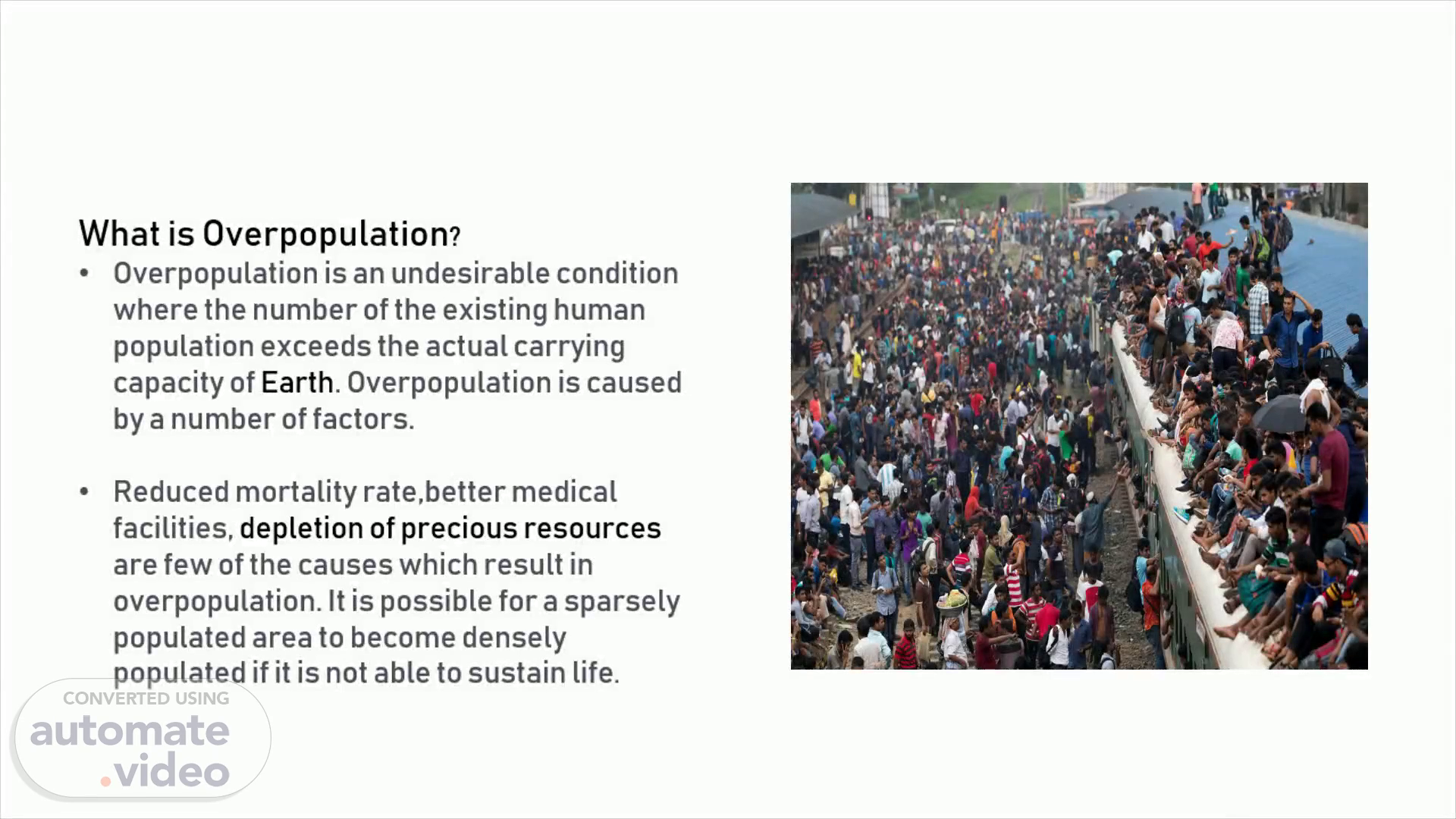
PowerPoint Presentation
Scene 1 (0s)
OVERPOPULATION IN INDIA: A CRISIS. . How Big Of A Problem Is Overpopulation?.
Scene 2 (23s)
SITUATION IN INDIA. India will surpass China: According to recent studies, India is set to surpass China as the world’s most populous nation by as early as 2024. In a country where 25 percent of the population is already living on less than $2 a day, many fear the growing population will only make the poverty situation worse. Connection between high fertility rate and poverty: T here is a clear connection between high fertility rates and poverty. In developing countries with high fertility rates, life expectancy and per capita income (two important indicators of well being) typically remain low..
Scene 3 (49s)
The good news. The positive news is that fertility rates in India have dropped significantly as of late, down to 2.2 births per woman. Yet the population is still growing at the world’s fastest rate at nearly 15 million people per year. Whatever measures are taken to combat overpopulation in India, it remains clear that overpopulation is a pressing issue with far-reaching implications on the environment, poverty and health.
Scene 4 (1m 10s)
DISTRIBUTION OF POPULATION IN INDIA UNEVEN POPULATION: India has an uneven population as per the 2011 census. The next census was to take place in 2021 which will now be held in 2022. The following are the features: Uttar Pradesh has the highest population which is followed by Madhya Pradesh, Bihar and West Bengal. Along with that, Rajasthan, Karnataka and Gujarat. All of this constitute 76% of the population..
Scene 5 (1m 31s)
Current Steps to Control Population in India A bold population policy is needed so that the economic growth of the country can keep pace with the demands of a growing population. Major steps which have been already implemented but still need to be emphasised. Increasing the welfare and status of women and girls The spread of education Increasing awareness for the use of contraceptives and family planning methods. Sex education Encouraging male sterilisation and spacing births, F ree distribution of contraceptives and condoms among the poor Encouraging female empowerment More health care centres for the poor.
Scene 6 (1m 56s)
HOW DO WE SUCCESSFULLY IMPLEMENT FAMILY PLANNING PROGRAMMES? Expand the basket of contraceptive choice: Along with pills and condoms and IUDs, injectable contraceptives seems to have a very high level of acceptance among the women especially in countries like Bangladesh. The situation will not be very different here in India as well. Injectables account for 73% of the most liked contraceptive choice. Have a better family planning policy and programme. injectable contraceptive, cent chroman and progestin only pills by the government of India has resulted in a much-needed shift from the terminal method of female sterilization, which accounted for two-thirds of contraceptive use in India until 2015-2016, to more modern limiting methods of contraception. Greater amount of education to service providers: Consistent efforts need to be made to educate not just the users but also the service providers in every aspect surrounding a newly introduced method so that their capacities are strengthened. The users will have better, more accurate access to information surrounding various contraceptive options, enabling them to make more informed choices. Media being a partner: The third and equally important partner is the media. Greater efforts need to be made by both the government and civil society organizations to educate media to promote unbiased reporting and avoid creating panic on introduction of new methods..
Scene 7 (2m 48s)
More of male involvement in family planning: It is imperative to recognise that family planning is not just a female issue. A disproportionate burden for the use of contraception falls on Indian women. Female sterilization accounts for more than 75 per cent of the overall modern contraceptive use in India T wo methods of contraception available to men - vasectomy and condoms - cumulatively account for about 12 per cent of total family planning methods. Most family planning programmes focus on women as primary contraceptive users while men are simply viewed as supportive partners. There needs to be greater recognition of the fact that decision-making on contraceptive use is the shared responsibility of men and women and programmes should cater to men as FP users. The family planning programmes should restructure their communication methods and strategies in a manner that includes men as both enablers and beneficiaries, hence making them responsible partners..
Scene 8 (3m 24s)
OUR PLAN FOR EFFECTIVE IMPLEMENTATION of ABOVE MEASURES:MONETARY INCENTIVES.
Scene 9 (3m 38s)
SMALL FAMILY HAPPY FAMILY(SFHF ) OR CHHOTA PARIVAAR SUKHI PARIVAAR(CPSP).
Scene 10 (3m 54s)
LESSON FROM CHINA IN IMPLEMENTATION. CHINESE EXPERIENCE OF INTRODUCING ANY NEW POLICY IS IN PHASES AND AREA SPECIFIC . SIMILARLY ,INDIA CAN GO AHEAD WITH ITS INCENTIVE SCHEME FROM MOST POPULATED TO LEAST POPULATED STATES IN PHASES INDIA BEING DEMOCRACY COERCIVE MEASURES WILL BE COUNTER PRODUCTIVE,SO INCENTIVES ARE THE ONLY WAY OUT.
Scene 11 (4m 11s)
Plan for Effective Implementation of SFHF. Identification highest family size constituencies in UP, MP, Bihar and West Bengal(FIRST PHASE) (LATER CAN BE DONE IN OTHER STATES) Implementation at District and Block Level making administrative machinery involving Local MP,MLA , DM and BDO along with Panchayat at village Level. Quarterly Report of Data and Coverage in the given Block and District.
Scene 12 (4m 29s)
Plan for Effective Implementation of SFHF. A GOOD INTERNAL ESPIONAGE DEPARTMENT IS NEED OF THE HOUR FOR EFFECTIVE IMPLEMENTATION This department should be directly under PMO SCRUNITY OF SCHEME AND SURPRISE CHECKS BY PMO CAN ONLY ENSURE ITS SUCCESS.